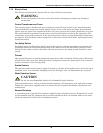
Alarm Descriptions and Solutions
46
6.1.10 Loss of Air Flow
A differential air pressure switch is used to indicate loss of air flow in Deluxe units.
Check for blockage of unit air outlet or inlet. Check blower motor fuses and overload reset. Check for
broken belts. Make sure blower wheels are tight to shaft. Run diagnostics to see if the fan contactor is
working properly.
6.1.11 Loss of Power
This alarm condition exists if the unit has lost power, or the disconnect switch was turned off before
the unit ON switch was pressed (to turn the unit Off). This local alarm will occur when power is
restored to the unit. A Liebert remote monitoring unit (optional) will immediately indicate loss of
power.
6.1.12 Low Humidity
If the return air humidity has decreased to the Low Humidity Alarm setpoint, check the following: Is
the unit setup for humidification (check DIP switch)? Check for proper setpoints. Does the room have
a vapor barrier to seal it from outdoor humidity? Are doors or windows open to outside air? Run diag-
nostics to make sure the humidifier system is working properly.
6.1.13 Low Suction Pressure
When the compressor is in cooling operation, a pressure switch monitors the suction pressure at the
compressor inlet. When pressure drops below a factory preset point, the switch opens. After the posi-
tive start kit time delay, and the switch stays open for five minutes, the alarm is activated. The alarm
stays active for ninety minutes.
Look for conditions that would cause loss of refrigerant. Check for piping problems such as leaks or
crimped lines. Check for inoperative components such as liquid line solenoid valve, low pressure
switch, expansion valve, and head pressure control valve. Check for closed service valves in the liquid
line or at the condenser or receiver.
6.1.14 Low Temperature
If the return air temperature has decreased to the Low Temperature Alarm setpoint, check for proper
setpoints. Run diagnostics to make sure all heating components are operating (contactors and
reheats). Check to see if the reheats are drawing the proper current (see nameplate for Amp rating).
6.1.15 Main Fan Overload
An optional tri-block overload is required for this alarm, and may or may not replace the internal
motor overload, depending on your model. The overload device is located next to the main fan contac-
tor in the line voltage section. The alarm is activated when the overload is tripped.
6.1.16 Short Cycle
On compressorized systems, the compressor has exceeded 10 cooling starts in a one hour period, or
the compressor has cycled 5 times in 10 minutes on the low pressure switch during non-cooling. This
can be caused by low refrigerant level (but not low enough to activate Low Suction Pressure alarm) or
a room cooling load that is small compared to capacity of the unit.
Check for leaks, crimped lines, and defective components. If room load is low, increase sensitivity to
reduce cycling (Proportional Control). On GLYCOOL
™
units, dirty filters can cause the coil freeze
stats to cycle the compressor.


















